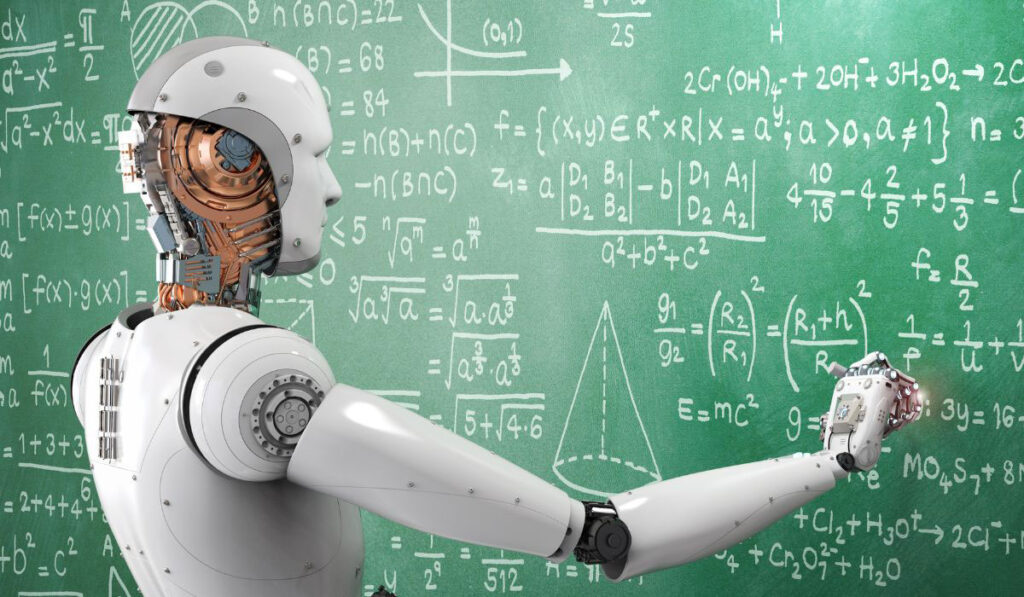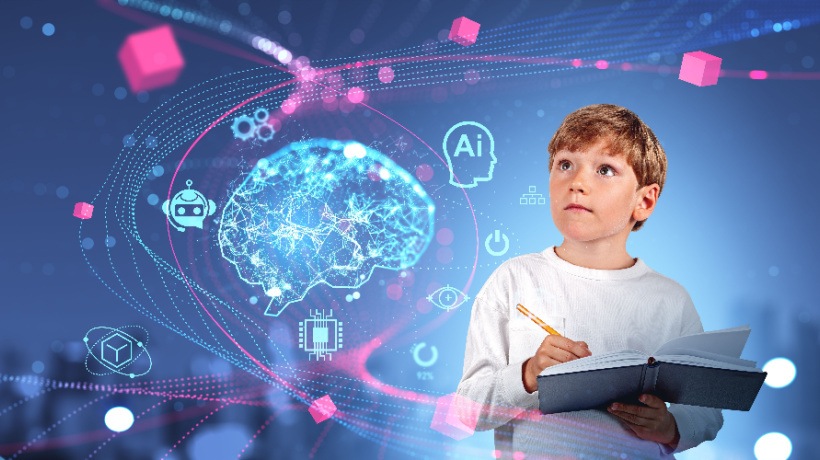Table of Contents
Market Revenue Matrix for AI in U.S. Education
The market for AI in education is expanding rapidly, with exponential growth expected over the next few years. Key factors driving this growth include the increasing demand for personalized learning tools, efficient administrative solutions, and advanced AI-driven platforms for both K-12 and higher education institutions.
| Year | Revenue (USD Billion) | Growth Rate (%) |
|---|---|---|
| 2022 | 4 billion | 10% |
| 2024 (Estimated) | 5440.5 million | 47.2% |
| 2025-2028 | 2.32 billion | 52.65% |
Introduction: The Rise of AI in U.S. Education
Artificial intelligence (AI) and cutting-edge technologies are reshaping education, particularly in the United States. From personalized learning platforms to intelligent tutoring systems and AI-enhanced administrative tools, AI is transforming how education is delivered and experienced. This blog delves into the current state of AI in U.S. education, highlights global AI usage in education, and explores future possibilities. Alongside this, we examine case studies showcasing AI’s impact and analyze the market revenue matrix of AI in education.

What is the Current State of AI in Education?
1. AI-Powered Personalized Learning
The most significant contribution of AI in education is the ability to personalize learning. Adaptive learning platforms like DreamBox and Knewton are tailored to students’ needs. These platforms analyze students’ learning habits and offer customized lessons that adapt in real time to the learner’s strengths and weaknesses.
For example, DreamBox allows students to navigate through math lessons at their own pace. If a student struggles with a concept, the system dynamically adjusts the curriculum to help them focus on weak areas. This tailored approach leads to improved learning outcomes, making AI a vital tool in ensuring that no student is left behind.
2. Intelligent Tutoring Systems
AI-powered tutoring systems are playing a crucial role in providing additional support to students outside the classroom. These systems, like Squirrel AI and Carnegie Learning, offer 24/7 tutoring assistance. They assess students’ responses, identify where they are struggling, and provide step-by-step guidance to improve their understanding of complex subjects. The advantage of AI tutors is their scalability, offering personalized support to students without the need for a human tutor’s constant presence.
3. AI in Administrative Roles
AI has also found applications in automating various administrative tasks, such as grading, scheduling, and student support. Tools like Gradescope allow educators to grade exams, assignments, and quizzes faster, freeing up time for lesson planning and student interaction. Arizona State University has also introduced an AI-driven chatbot named “Sunny,” which assists students with queries related to course registration, financial aid, and more. These advancements lead to increased operational efficiency in educational institutions.
4. Automated Grading Systems
Automated grading is another transformative application of AI. Tools like Gradescope are increasingly used to assess assignments, saving teachers hours of work. These tools can handle multiple-choice tests, essays, and programming assignments. As AI continues to evolve, the sophistication of automated grading will also increase, potentially covering more complex subjects that require nuanced evaluation, such as creative writing or art critiques.

AI in Education: Case Studies
1. Carnegie Learning: Data-Driven Math Education
Carnegie Learning has pioneered AI-driven education in math. Their intelligent platform uses machine learning algorithms to analyze how students solve problems and where they struggle. Based on this data, the system offers personalized suggestions for improvement. In one study, students using the Carnegie Learning platform showed significant improvements in standardized math test scores compared to those who did not.
Key Results:
- 22% improvement in standardized test scores.
- Enhanced student engagement and motivation.
2. Arizona State University: AI-Powered Chatbot “Sunny”
Arizona State University’s chatbot, “Sunny,” is an AI-powered virtual assistant designed to handle student queries related to administrative processes. Sunny has handled over a million questions, ranging from enrollment issues to financial aid inquiries, significantly reducing the administrative workload. The system is programmed to learn from its interactions, improving its responses over time.
Key Results:
- Over 1 million queries handled.
- 40% reduction in administrative staff workload.
3. Khan Academy: Personalized Learning at Scale
Khan Academy has integrated AI into its learning platform to offer personalized education to millions of students. The AI system tailors practice problems and learning resources to individual students based on their performance. This approach has proven particularly beneficial for students who may not have access to personalized instruction in traditional classroom settings.
Key Results:
- Significant improvement in student success rates, especially in underserved communities.
- Scalable model capable of serving millions globally.

Which Countries Use AI in Education?
While the U.S. is a leader in AI-powered education, other countries are also making significant strides in incorporating AI into their educational systems. Let’s take a look at some examples:
1. China: A Global Leader in AI-Driven Education
China is at the forefront of AI integration in education. With companies like Squirrel AI and TAL Education, China has made AI-powered tutoring and adaptive learning mainstream. These platforms track students’ learning progress and tailor lessons to fit their individual needs. China’s government is also heavily investing in AI research, aiming to dominate the global AI education sector by 2030.
2. United Kingdom: Growing AI Adoption
The United Kingdom is witnessing an increasing integration of AI in schools and universities. Century Tech, a UK-based company, provides AI-driven platforms that offer personalized learning paths based on individual student performance. The UK government has also launched AI-focused educational initiatives aimed at preparing students for the future workforce.
3. India: AI for Scalable Education
India, home to some of the largest EdTech companies like BYJU’S and Embibe, is rapidly embracing AI in education. AI helps these platforms cater to millions of students by offering personalized learning experiences based on performance data. AI-driven tutoring systems are especially critical in a country where access to quality education is uneven, offering scalable solutions to bridge the gap.
4. Singapore: Cutting-Edge Learning
Singapore’s education system is often lauded as one of the most forward-thinking globally. AI is integrated into classroom instruction, particularly in STEM subjects. The Singaporean government supports various AI-driven educational initiatives, including research programs and collaborations with leading EdTech companies.

What is the Future of AI in Education?
The future of AI in education is bright, with numerous possibilities for enhancing learning experiences and improving outcomes for students and educators alike. As AI technology advances, the educational sector is poised to undergo even more profound changes.
1. Hyper-Personalized Learning
AI will continue to revolutionize personalized learning, evolving to analyze more complex data from students. This could include tracking attention spans, engagement levels, and even emotional responses during lessons. AI systems will be able to offer hyper-personalized learning experiences that cater to each student’s unique needs, learning style, and pace.
2. Immersive Learning with AR and VR
The combination of AI with augmented reality (AR) and virtual reality (VR) will create immersive learning environments. For example, students could virtually explore historical events or conduct scientific experiments in safe, simulated environments. AI will tailor these experiences based on individual learning objectives and performance.
3. AI-Driven Professional Development
AI can help teachers as much as it helps students. By analyzing teaching methods and outcomes, AI can offer insights to educators, helping them refine their strategies and approach. Continuous professional development will become more data-driven, helping teachers adapt to the evolving educational landscape.
4. AI for Student Wellbeing
AI has the potential to monitor student wellbeing by analyzing behavioral patterns, engagement, and emotional health. By identifying students who may be struggling with mental health issues, AI can help schools and universities offer timely interventions and support.
5. Ethical and Responsible AI
As AI becomes more ingrained in education, concerns about data privacy, algorithmic bias, and the ethical use of AI will become central. The future of AI in education will also depend on establishing frameworks that ensure fairness, transparency, and responsibility in AI applications.
What is the current state of AI in education?
AI in education is growing rapidly, particularly in the U.S. It is being widely used for personalized learning, intelligent tutoring systems, automated grading, and administrative efficiency. AI-powered platforms like DreamBox and Knewton offer adaptive learning paths tailored to individual student needs, while tools like Gradescope automate grading processes. Universities like Arizona State also leverage AI chatbots to manage administrative tasks efficiently. The integration of AI in education is improving both student outcomes and institutional operations.
Which countries use AI in education?
Several countries around the world are adopting AI in their education systems:
United States: One of the global leaders, with AI being used in K-12 schools, universities, and EdTech companies.
China: A frontrunner in AI-driven education, particularly with companies like Squirrel AI offering intelligent tutoring systems.
United Kingdom: AI is being used in personalized learning platforms, such as Century Tech, to enhance educational experiences.
India: AI-driven platforms like BYJU’S and Embibe provide scalable personalized learning in a country with a large student population.
Singapore: Known for its innovative education system, Singapore integrates AI for personalized learning and immersive technologies in classrooms.
What is the future of AI in education?
The future of AI in education is filled with exciting possibilities:
Hyper-personalized learning: AI will offer even more tailored education experiences by analyzing individual learning styles, emotional responses, and engagement levels.
Immersive learning: AI combined with AR/VR will provide interactive, immersive learning experiences that enhance student understanding of complex subjects.
AI for educators: AI will help educators refine teaching strategies through data-driven insights, offering personalized professional development.
Ethical AI: There will be a growing focus on developing ethical AI frameworks to ensure data privacy, fairness, and transparency in AI applications in education.